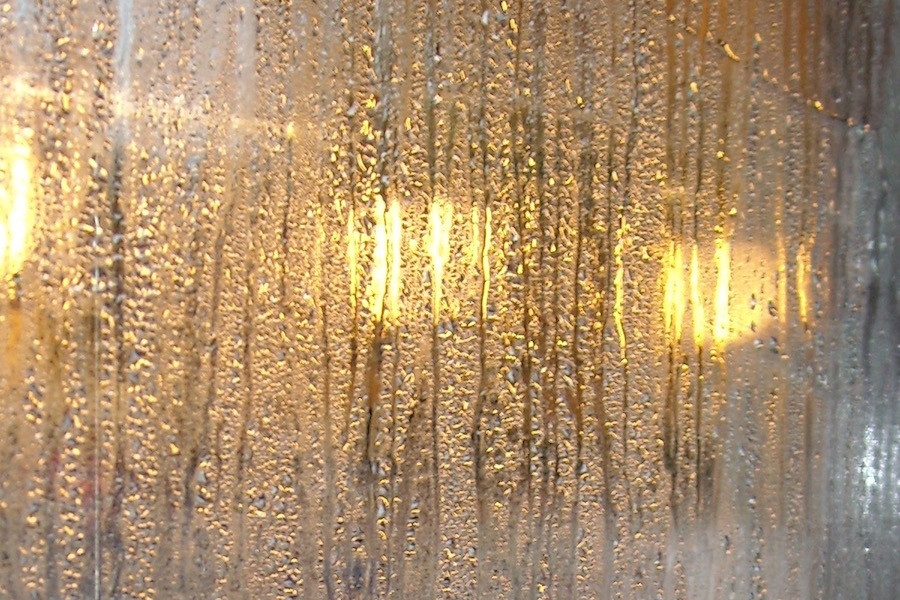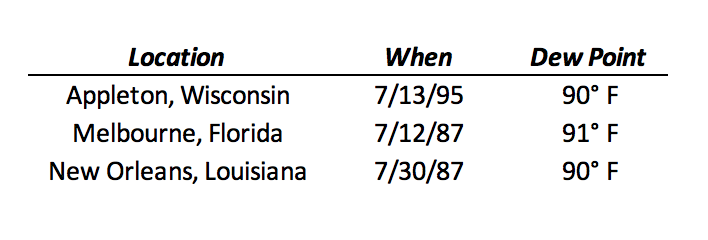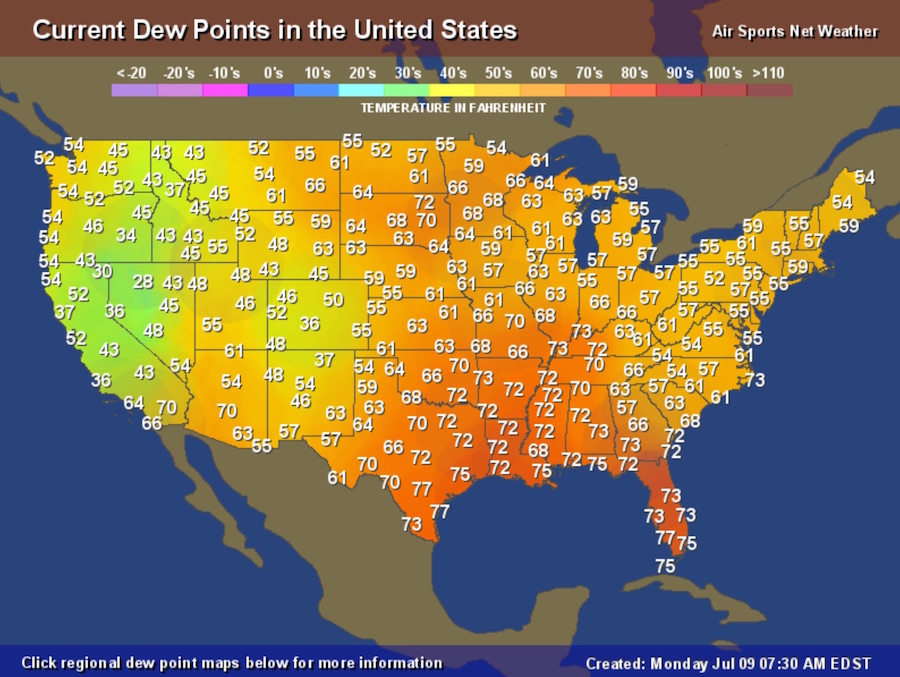Make Dew Point Your Friend for Humidity

I’ve been on a bit of a mission for the past several years. My goal is to get more people thinking about humidity in terms of dew point rather than relative humidity. Why? Because relative humidity is misleading. That whole “relative” thing is a bit slippery, you know.
For example, I’ve had a building industry professional who deals with this stuff tell me that in his area, they regularly see both temperature and relative humidity in the 90s (Fahrenheit and percent, respectively). It’s a common misconception. Last week I was speaking with a client in the mid-Atlantic who told me it gets up to 98° F and 95% relative humidity where he builds.
Putting humidity in perspective
I don’t doubt either of those people. I just think their timing is a bit off. Yes, hitting temperatures in the 90s, even up to 98, is certainly possible in the majority of the United States. And having relative humidity at 90% or higher is also possible, especially in the Eastern half. They just don’t happen at the same time. When they do, new records are set.
Yes, meteorologists and climatologists keep records of such things as highest dew point. Dew point is the quantity you have to look at for records because it actually tells you how much water vapor there is. Relative humidity tells you how close you are to saturation (100% RH), which happens when the water vapor starts condensing out as you try to add more.
So, let’s look at some records. Here are the highest dew points recorded in the US:

Let’s now take a look at what the air temperature (dry bulb) and relative humidity was for each of those:

You’re probably wondering now about the rest of the world. The highest dew point temperature ever recorded was 95° F on 8 July 2003 at Dhahran, Saudi Arabia. The air temperature at the time was 108° F, making the relative humidity a relatively dry-sounding 68%.
Yes, the mythical 90/90 day for air temperature and relative humidity is possible. It’s happened at least once before…and it set a record. But those are far from normal conditions.
An 80/80 day, however, is quite likely on the humid side of North America. The dew point in those conditions is 73° F. If you live in Houston or Mobile or Florida, that’s about the low end of humidity for you this time of year. Here in Atlanta, that’s about where we top out.
Here’s one more perspective on dew point: When you keep your house at recommended design conditions of 75° F and 50% relative humidity, the dew point is 55° F. That’s comfortable. In my condo, we’re usually at 74° F and about 58% relative humidity. The corresponding dew point is 58° F, and that’s still comfortable. (But you might want to read about how I made one little change to jack up our relative humidity to over 70% back in 2014.)
Make dew point your friend
High relative humidity certainly does happen. It usually coincides with lower air temperatures, though. As the temperature rises, the relative humidity goes down. This morning when I awoke, for example, the relative humidity here in the Atlanta area was 87%. Although that sounds bad, the air temperature was 65° F and the dew point was a nice, dry 61° F. If we keep that same dew point as the temperature rises to the predicted high of 89° F, our relative humidity will drop to a desiccating 39%.
The weather app on your phone probably shows the dew point for your location so if you get in the habit of looking at it, you’ll have a better idea of the humidity. Here in Atlanta, our normal summer range is from the high 60s to the low 70s. On the Gulf coast, it’s mid to upper 70s.
Here’s a screenshot of the dew point map on usairnet.com, showing dew points all across the United States at 7:30 this morning, Eastern time.
Our bodies respond to relative humidity because one of the ways we cool off is through evaporation of sweat. Higher relative humidity makes that process more difficult. But if the high relative humidity corresponds to a low air temperature, your body won’t need as much cooling as it will at a high temperature, high humidity time.
Checking the dew point gives me an idea of how humid it really is. When I get up in the morning and see a dew point of 61° F, as it is this morning, I know it’s a great day to be outdoors because it’s going to feel like I’m in Santa Monica, California…well, almost anyway.
There you have it. Relative humidity isn’t what a lot of people think it is. Dew point will always be your friend, though.
Related Articles
The Problem with Relative Humidity
Dew Point — A More Meaningful Measure of Humidity?
Daniel Boone’s Dew Point Problem
Two Rules for Preventing Humidity Damage
NOTE: Comments are moderated. Your comment will not appear below until approved.
This Post Has 16 Comments
Comments are closed.


Thank you for blowing up the
Thank you for blowing up the old “90F and 90%” saying. I used to say it myself, until I learned how the HVAC industry looks at humidity.
90/90 days do happen. Those
90/90 days do happen. Those two 90s just don’t happen at the same time. If you had 90% RH while the temperature was 90° F, the dew point would be 87° F. That’s not record setting for the whole US, but it probably would be a record in most locations.
Hi Allison,
Hi Allison,
I have long been frustrated about why we are so obsessed with dry bulb temperatures. It’s almost meaningless in most hvac comfort situations. Our bodies feel the ENTHALPY of our surroundings, and we cool ourselves relative to dew point temps (or wet bulb temps).
So, why don’t smart thermostats control by dewpoint?
I have an idea for an invention: we devise a personal comfort data logger. This device clips onto your shirt and measures dewpoint temp, drybulb temp, RH. In addition, this device has provision for user inputs:
“I’m too hot”….I’m neither hot nor cold….”I’m too cold”
“It’s too moist”….humidity is “about right”….”It’s too dry”
As we go about our day moving from room to room doing our thing, the datalogger sends data to our HVAC controller. In an ideal application, each room is served by ductless air handler (preferably chilled water as cold source), and each AHU has a condensate removal pump.
But even in a typical home or building space, the system is informed better to maintain comfort. For a large building, why not assign 5 data loggers to 5 randomly picked people each day and take an average of polling the data, room by room?
At any rate, I’d just about kill for a smart thermostat that will let me create setpoints by dewpoint. Are there any that can?
Contrary to common misunderstanding, Phoenix, Arizona is INSANELY humid during our monsoon season. 105f @ 40% RH is absolutely brutal. Yes, it’s a “dry heat” for 4 months of our cooling season, but August is insane. I’ve been so frustrated, as I am rarely comfortable and my bills are always way higher. FWIW, we have a 2780 sqft, 2 story house with massive picture windows everywhere. The house came with a pair of 3.5 ton AC’s, which according to your other blog entry is very oversized (I timed it and today @ 101f @ 12% RH outdoors this evening, the unit will come on for less than 12 minutes at a time.
Dewpoints in peninsular
Dewpoints in peninsular Florida run in the low to mid 70s pretty much 24/7 4-5 months per year…and this is why I cringe whenever I hear from folks in conventionally framed who set thermostats below 72.
In one extreme case of setting at 65 every night, the owners basically “totalled” their home using their thermostat – ruinous accumulation of mold behind drywall.
Excellent point, Curt. And I
Excellent point, Curt. And I like that analogy. Everyone knows what it means to total a car. People who understand dew point are not likely to total their house with the thermostat, as you described.
I love this turn of phrase,
I love this turn of phrase,
“a desiccating 39%”
Thanks, Andy. I thought
Thanks, Andy. I thought briefly about using a different word, so I’m glad I didn’t.
Has anyone found a good dew
Has anyone found a good dew point sensor/meter?
Jacob, there are some
Jacob, there are some available. Check TruTech Tools (https://www.trutechtools.com). I usually use a thermo-hygrometer or a temperature and relative humidity data logger and then convert to dew point with the help of an app on my phone.
Thanks Allison. Are there any
Thanks Allison. Are there any home thermostats that can control a whole house dehumidifier using dew point? It seems like most of the common products only use RH.
Jacob: Allison must be
Jacob: Allison must be asleep, so I will try to answer your question about thermostats using dewpoint instead of relative humidity. I am not aware of any. There is no reason that thermostat manufacturers couldn’t do it, but I am guessing that their marketing people see no interest in it beyond the people on this blog. If you keep your space temperature at about the same temperature all of the time, then controlling to RH should do the same as controlling to dewpoint. But if you do have significant temperature setpoint changes, or you turn off the cooling system at times, dewpoint probably would be a preferable control variable.
Thanks Roy. That’s exactly
Thanks Roy. That’s exactly what is most appealing about using dew point to control humidity. The ability to allow a building in the Southeast to get to 80-90F when it is unoccupied, especially for a week or two, without increasing the risk of moisture build up.
However, it’s possible that just setting the dehumidifier to ~50% would work well enough to avoid any potential issues assuming no major building envelop problems. I’m not really sure though.
Thank you for posting this
Thank you for posting this Allison. It seems to me that your real mission here is to get people to use wet bulb temperature. Yes, dew point tells you how much water vapor is in the air, but in terms of comfort, wet bulb (which is always between the dry bulb temperature and the dew point) is the temperature the person experiences with normal air flow (i.e. evaporative cooling). Granted, this is much harder to measure or explain to the average layperson, but so is the difference between dew point and relative humidity. People understand sweating (evaporative cooling) or being colder in winter when wet (more evaporative cooling).
Also, it seems to me that the easier way to state your point is: if the dew point temperature is approximately the dry bulb temperature, than the relative humidity is high.
Also love the “desiccating 39%” phase, I’ll have to steal it.
David, I did write about wet
David, I did write about wet bulb temperature once, but I wouldn’t say that’s my mission. As you wrote above, wet bulb isn’t quite as accessible as dew point, and it’s not shown in my weather app.
Here’s that article I wrote about wet bulb:
A Sticky Psychrometric Situation: Wet Bulb Temperature
David, I disagree that wet
David, I disagree that wet-bulb temperature is hard to measure. It is probably the easiest humidity metric to measure since all you have to do is swing a wet temperature sensor (sling psychrometer). Also, wet-bulb temperature is not a direct measure of comfort. A line of constant comfort on a psych chart does not correspond to a line of constant wet-bulb temperature. A constant comfort line on a psych chart is much “steeper” than a constant wet-bulb line (see Chapter 9 of the ASHRAE Handbook of Fundamentals).
Long-winded question and
Long-winded question and comment.
First, the question – why doesn’t anyone make a dew-point thermostat? Especially considering that many homes now have complex HVAC equipment including a heat-pump/AC, ERV, and (de)humidifier?
Based on temperature and humidity readings, a smart dew-point thermostat could decide whether an indoor DP of 55F is most easily achieved by running just the (de)humidifier, or the heat-pump, or both.
I am currently doing something like this using a node-red flow that controls a bunch of relays.